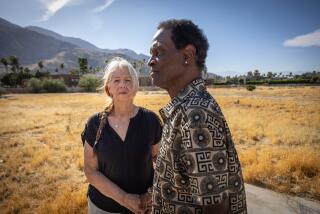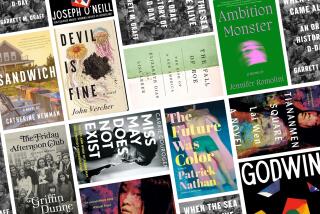Laguna Beach Writer Finishes Sequel to His Controversial ‘Cay’
- Share via
Responding to countless requests from young readers over the years, Laguna Beach author Theodore Taylor has finally written a sequel to “The Cay,” his award-winning 1969 novel about a young white boy who is forced to confront his racial prejudices when he is shipwrecked with an old West Indian black man during World War II.
Harcourt Brace Jovanovich has announced that the sequel, tentatively titled “Timothy of the Cay,” will be published in September, 1993.
“The Cay,” which won the prestigious Lewis Carroll Shelf Award and a half-dozen other literary awards, was made into an NBC movie starring James Earl Jones in 1974; this year an audiocassette recording narrated by Levar Burton was released.
With nearly 2.5 million copies in print worldwide, “The Cay” is Taylor’s most popular book. But the novel, which is required or recommended reading in schools across the country, has generated heated controversy over the years.
Criticized by the Council on Interracial Books for Children and other groups and individuals in the 1970s for being offensive to blacks and for reinforcing racial stereotypes, “The Cay” was removed from the shelves in public and school libraries in certain parts of the country.
Among the criticisms of the book are Taylor’s description of the black male character, Timothy, a “huge” black seaman whose “ugly,” scarred face initially terrifies the boy. The illiterate seaman, who speaks in a Creole dialect, is also seen as being stereotypically servile, calling the boy “young bahss” and using other self-effacing language.
The National Assn. for the Advancement of Colored People in Ventura County demanded in January that the Simi Valley Unified School District stop using the novel in classrooms.
The book was brought to the NAACP’s attention by the mother of a junior high school student who said her son was offended when the novel was taught in a class in which he was the only black student.
Simi Valley school officials have since asked teachers not to teach “The Cay” until a district-appointed committee of instructors, librarians and administrators has completed its review of the book.
Calls to the Ventura County chapter of the NAACP were not returned. But Theodore Green, education committee chairman for the organization told The Times in January that the book “is slanderous. It’s defaming. It’s belligerent.”
Although the group does not want the book removed from school libraries, chapter president John Hatcher said in January that he does not think that teachers should teach “The Cay” in class.
“It tends to stereotype blacks,” he said, adding that he does not accept the argument that the book teaches children about the nature of racial prejudice.
Set in 1942, “The Cay” is the story of Phillip, an 11-year-old living in Venezuela with his mother and oil company worker father. When the boy and his mother try to return home to Virginia, their ship is torpedoed by a German submarine.
Phillip, who is injured during the attack, finds himself alone on a raft with Timothy, a 70-year-old black deckhand. They seek refuge on a tiny, uninhabited island where the boy, reflecting his Southern parents’ prejudices, initially regards Timothy as inferior.
But when the boy’s injuries cause him to lose his sight, he must depend on Timothy for survival and, in time, he abandons his prejudices and feelings of superiority as he learns to admire and respect the old man for his courage, compassion and wisdom.
Speaking from his home in Laguna Beach this week, Taylor said “The Cay” has “never had one bit of trouble” in Orange County, “and it’s taught (in schools) throughout the county.”
Ironically, the book--which Taylor wrote in 1968 before the assassination of Martin Luther King Jr.--is dedicated “to Dr. King’s dream, which can only come true if the very young know and understand.”
In writing the novel, which is written from the white boy’s point of view, Taylor, 70, said he hoped to achieve a subtle plea for better race relations and more understanding.
“The thing about it,” he said, “is black children do not need to be taught about racism, but white children, in my opinion, do need to be taught, and that’s what the purpose of the book was. That’s why it was dedicated to Martin Luther King.”
Despite the criticisms, Taylor said he would not write the book differently today.
He said he purposely made Timothy facially ugly to reinforce the fear and hate of black people that had been programmed into Phillip.
“The white boy was a racist and the old black man, had he looked like Harry Belafonte, I don’t think the white boy would have (initially) feared him,” he said.
Although Timothy had never gone to school and was illiterate, “he was a very wise man,” said Taylor, who also defends the use of the Creole dialect, saying: “You wouldn’t want an old West Indian speaking like a black person from Brooklyn.”
Taylor, who recently won an Edgar award from the Mystery Writers of America for his young adult novel “The Weirdo,” said that over the years he has received about 200,000 letters from young fans of “The Cay.”
“What happens is a teacher will use it (in class) and then her entire class will write,” Taylor said. “I get packets of 35 to 40 letters, and this happens again and again--sometimes five packets a week.”
And, he said, the general tone of the letters is always the same: “The black kids regard (Timothy) as a hero, as do the white kids.”
As Taylor sees it, the book “absolutely achieves what I set out to do, and I think in the minds of the great majority of teachers and librarians in this country, it does that.”
An editorial in the Ventura Star-Free Press, in response to the NAACP’s call for “The Cay” to be removed from classrooms, called Taylor’s book a “sensitive indictment of racism and the cultural attitudes that spawn it. . . . It’s hard to envision a simpler and more effective way of arguing the fundamental irrationality of racism to the book’s youthful target audience. In the hands of a good teacher, ‘The Cay’ presents an opportunity to discuss cultural standards of physical attractiveness, the roots of interracial mistrust and fear, and the underlying ties uniting the human race.”
Lynn Eisenhut, children’s services coordinator for the Orange County Public Library, said “The Cay” is on reading lists at many county schools. As far as she knows, Eisenhut said, none of the library’s branches has ever had a parent express concern about the book.
“We’re familiar with concerns other organizations have expressed and can certainly sympathize with their concerns,” she said, “but I think that Taylor (in the past) has done a credible job of explaining what his intent was, and the book has received a number of good critical reviews.”
Eisenhut, who has read “The Cay,” said the book is, “first of all, a good adventure-survival story. And secondly, I do think it does a credible job of exploring the different ways that people perceive one another based on background.”
Eisenhut said the boy in the book undergoes a change in how he feels about the seaman as the story progresses, “and so I think kids can get that message out of the book.”
Given the continued popularity of “The Cay,” why did Taylor wait so long to write a sequel?
“Lack of courage,” he said. “Because you know you’re going to be compared. It’s absolutely certain they’re going to say it isn’t as good as the first one. That’s the history of sequels.
“But my final decision came after getting all these letters from young readers saying, ‘When are you going to be do a sequel?’ ”
“Timothy of the Cay” will precede and follow events portrayed in “The Cay.” In alternating chapters, it will follow Timothy’s life as a young man while continuing the story of young Phillip.
And the sequel, which includes scenes in which the boy questions his mother’s racism, will contain an even stronger message than the first.
The need for that message, Taylor said, has not diminished since “The Cay” was published 23 years ago.
“The riots in L.A. indicate a need for understanding,” he said.
More to Read
Sign up for our Book Club newsletter
Get the latest news, events and more from the Los Angeles Times Book Club, and help us get L.A. reading and talking.
You may occasionally receive promotional content from the Los Angeles Times.






